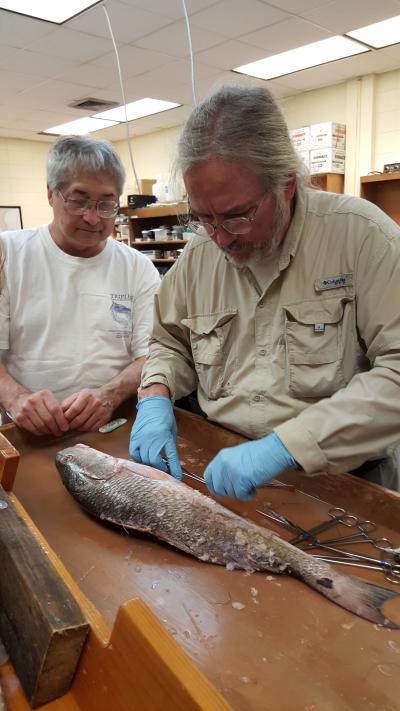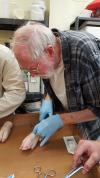GCRL Scientists Learn Cutting Edge Surgical Techniques to Protect Animals During Research
Wed, 04/13/2016 - 01:07pm | By: James Skrmetta

Scientists at The University of Southern Mississippi's Gulf Coast Research Laboratory spent April 5 training with surgeon Drew Hildebrandt to ensure the safety of animals used in research projects.
Jill Hendon, assistant director of GCRL's Center for Fisheries Research and Development (CFRD), prepared her team of 10 researchers for an upcoming research project by having them learn three suture techniques from Hildebrandt, a surgeon from University of Mississippi Medical Center.
“I want the project to be a success,” said Hendon. “But more importantly, I want the fish to be safe.”
Hendon's team received a Mississippi Tidelands grant to fund research to track the habits of juvenile red drum and bull sharks in the western portion of the Mississippi Sound. A large portion of the project involves acoustic tags being implanted into the live fish. As part of the Institutional Animal Care and Use Committee's (IACUC) protocol, Hendon had to show evidence that her team was taking the proper steps to ensure animal safety before they could begin.
“We review each project to oversee exactly how they impact the animals,” said Frank Moore, IACUC chair. “Training of this level minimizes any inconvenience on the animals.”
The group of researchers began practicing on pig's feet before moving on to dead red drum and bull shark.
“As a researcher, you can't just look at them as animals or simply pieces of data,” said Jennifer Green, CFRD technician. “We have to worry about their pain levels and overall health.”
Green said the training is vital to this research project and is important in advancing the quality of work being done by GCRL scientists.
“This allows us to do so much more in the field,” she said. “Practicing these advanced techniques under the eye of a great surgeon is an invaluable experience.”
Moore said the review process was put into place to protect the animals being used for research.
“An ethical code must be followed with invasive research,” he said. “Advanced skills, such as surgical techniques being learned, benefit both the scientists and the animals.
In the class, Hildebrandt educated the group on three types of sutures: simple-interrupted suture, cross-stitch suture and a mattress suture.
“The training is essential,” Hendon said. “To do advanced work, we must be trained in advanced techniques.”
Green said practicing surgical techniques was something she never thought she would be doing when she began her career in 2007.
“It's really cool to be out in the field and know I have this new set of skills,” she said. “I'll admit that first cut is still a little stressful though.”
Hendon said she is confident in her team's ability to properly install the acoustic tags and for the success of the project.
“There is a special satisfaction in a project going really well,” she said. “But it's even more special when you do it the right way.”
